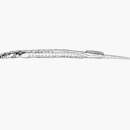Life Cycle
provided by Fishbase
Female deposits eggs on the ventral surface of the male trunk's or tail , where they are incubated for several weeks. Males may be brooding at 12 cm SL (Ref. 5316).
Migration
provided by Fishbase
Anadromous. Fish that ascend rivers to spawn, as salmon and hilsa do. Sub-division of diadromous. Migrations should be cyclical and predictable and cover more than 100 km.
- Recorder
- Crispina B. Binohlan
Morphology
provided by Fishbase
Dorsal spines (total): 0; Dorsal soft rays (total): 37 - 54; Analspines: 0; Analsoft rays: 4
Biology
provided by Fishbase
Occurs in relatively shallow (25-150 cm), still to slow-flowing water (Ref. 6028). Inhabits freshwater streams, rivers and estuaries. Juveniles and subadults are usually found in estuaries while adults are found upstream in freshwater areas. Feeds on worms, crustaceans and zooplankton. Ovoviviparous (Ref. 205). The male carries the eggs in a brood pouch which is found under the tail (Ref. 205). Not seen in markets (Ref. 12693)
- Recorder
- Crispina B. Binohlan
Importance
provided by Fishbase
fisheries: of no interest; aquarium: commercial
- Recorder
- Crispina B. Binohlan

